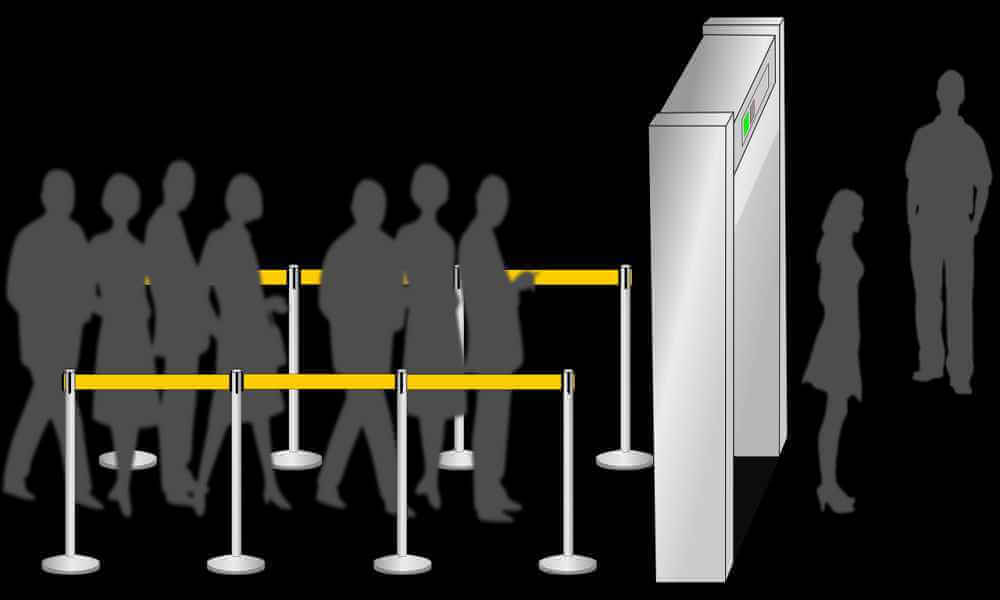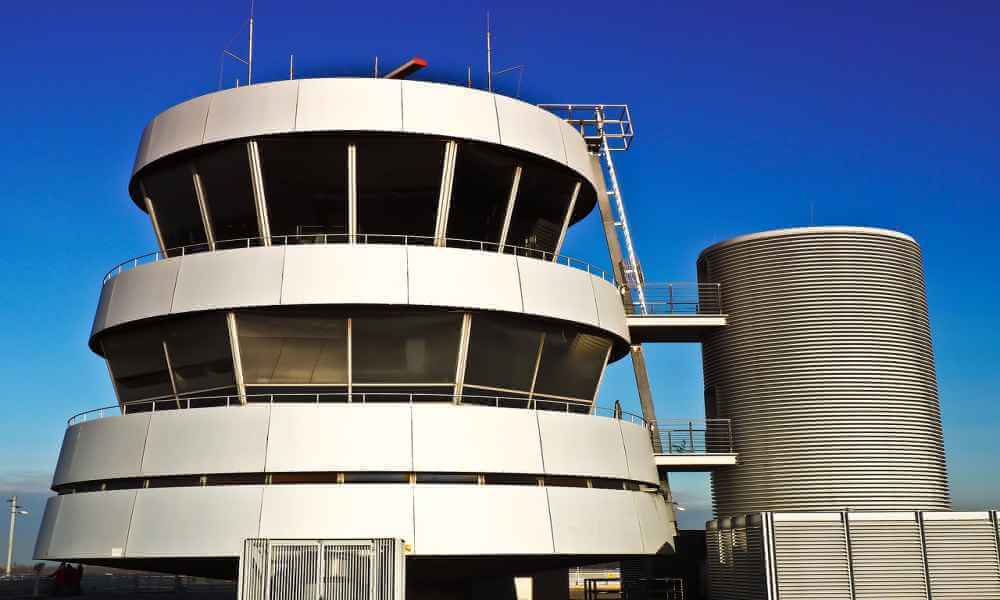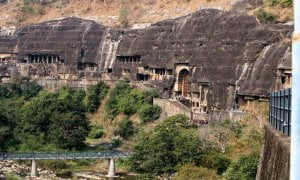Airport Security Management: Airport security refers to steps and measures taken to safeguard passengers, airport and airline crew, aircrafts and airport infrastructure and cargo at the airports from any potential harm, accidents and threats. In order to achieve this, a combination of both human and material resources is employed at various security check points.

These measures enable the authorities from protecting people and assets at the airport from unlawful interferences such as acts of terrorism, sabotage, threat to life and property, communication of false threat, and bombing etc.
Airport Security Management has increasingly become important in the present times given past unfortunate incidents associated with airports.
Importance Airport Security Management
- Large number of people travel through airports and can be seen as potential targets for terrorist attacks and other threats.
- Large number of people any also increase the threat for hijacking of planes and other undesirable incidents within the aircraft harming passengers and crew.
- Airports can be used for transporting dangerous and harmful materials such as lethal weapons, narcotic drugs and other smuggled items.
- Airports, to any country, one of the most critical infrastructures. Any harm to the airports may result in seriously crippling the countries transport system.
- Airport security also is way to reassure people of a country and people travelling to a country that the country in question employs sufficient measures to ensure the safety of its people.
Implementing Agency of Airport Security Management
The agency responsible for protecting airports varies from one country to another. While some countries may have special agencies or forces assigned for the purpose of airport security, some other countries may authorize airport security to local police or security agencies. In many a countries facing extreme threat, airport security is managed by the countries armed forces.
In India, airport security is governed by the Airport Authority of India. The AAI has further constituted a separate body called as the Bureau of Civil Aviation Security (BCAS) to carry out the function of safeguard the passengers, crew, ground personnel, the general public and the airport infrastructure against unlawful acts as per ICAO Standards and Recommended Practices laid down in Annexure-17 to the
Chicago Convention. BACS was set up in the year 1978 with the responsibility of laying down standards and measures in respect of security of civil flights at International and domestic airports in India.
Role and Functions of Airport Security Management
The functions of Bureau of Civil Aviation Security as stated in the BCAS website are:
- ‘Laying down Aviation Security Standards in accordance with Annex 17 to Chicago Convention of ICAO for airport operators, airlines operators, and their security agencies responsible for implementing AVSEC measures.
- Monitoring the implementation of security rules and regulations and carrying out survey of security needs.
- Ensure that the persons implementing security controls are appropriately trained and possess all competencies required to perform their duties.
- Planning and coordination of Aviation security matters.
- Conducting
- Surprise/Dummy checks to test professional efficiency and alertness of security staff.
- Mock exercise to test efficacy of Contingency Plans and operational preparedness of the various agencies’.
To carry out the above listed functions, BCAS has appointed a paramilitary force known as the Central Industrial Security Force (CISF). CISF has formed an Airport Security Group to protect all airports in India. Every airport in India has been given an APSU (Airport Security Unit) which is a trained unit to counter unlawful interference with civil aviation. Apart from the CISF, every domestic airline in India has its own security teams, which look after the aircraft security.
Airport Procedures and Measures towards Airport Security
Although, airport security had been a matter of prime importance for airport authorities around the world, but even since the recent events such as America’s 9/11 and Air India’s plane hijacking, airport security has further become a function of critical importance for the civil aviation authorities any country. Discussed below are some of the most widely used measures across all airports globally to safeguard passengers, crew, and cargo and airport infrastructure from potential unlawful interferences.
- Barriers around airports: Airports are normally built with high fences, barriers and walls in order to act as a first line defence from persons trying gain access unlawfully. These barriers or fences are difficult to climb enclose the entire airport property. Security personnel of the airport undertake patrols regularly to scan the perimeter in case any breach or damage to the barrier.
Especially in the case of sensitive areas such as the fuel depots or the terminals and baggage handling facilities are further secured with additional security measures like more fences and security checkpoints. All access gates attached these fences are monitored both by a security personnel station and surveillance cameras.
Also measures are taken not to allow any heavy vehicles in close proximity to the airport. There are several check points installed along the road leading to the terminal building to detect any potential treat. All vehicles are also parked slightly away from the terminal building to ensure there is no direct threat to the terminal.
- Identity Checks: In order to gain access into the airport passengers must produce a valid ticket along with any of the prescribed photo identity documents. The airport crew is also expected to pass through this identity check each time they enter the terminal.
In India, CISF security personnel personally check through the documents to verify the identity of the passenger. Also, in some larger airports today, random baggage checks using x-ray machines are done right after the passenger enters the terminal and before he proceed for the check-in.
Also, passengers are educated and sufficiently warned through public address system or displays at airports telling passengers not to leave their bags unattended. These are very important questions as innocent passengers’ bags may to be used transport unwanted items like weapons, bombs or smuggled items which may pose to be of security threat.
- Metal Detectors at the doorway and Security Check: every one entering the terminal is mandatorily made to undergo the metal detectors placed within the entrance of the terminal and also during the safety checks. These metal detectors are equipped to signal or beep when persons are carrying any metal objects with them or wearing on their body.
At the safety check area all passengers’ baggage and belongings must undergo the xray machine including mobile phones, wallets, handbags, belts, boots and jackets. Passengers also are frisked employing a handheld detector by security personnel and lots of a times physically examined. Once examined passengers’ boarding passes are stamped by the personnel.
- X-Ray Machines and its uses: While the passengers undergo the metal detectors, their baggage and other belongings are skilled the X-ray machine placed nearby within the security check area. A conveyer belt carries each item past an X-ray machine and baggage are placed in tray.
Items like laptops, mobile phones and other electronic items are asked to be placed separately during a tray. Since different materials within the baggage absorb X-rays at different levels, the x-ray image on the monitor shows the safety personnel to ascertain distinct items inside passengers’ bags.
Items are typically shown in distinct colours on the display monitor, supported the character of fabric within the bag, to represent one among three main categories Organic, Inorganic and Metal. Any undesirable metal items are physically checked by the personnel if required. All baggage is later stamped indicating that they need skilled a radical examination.
- Baggage Scanner: For the luggage checked in and also for cargo an outsized sized X-ray machine and, sometimes, CT Scanners are wont to detect any undesirable items which will be of threat once on board the flight.
- Immigration Check: just in case of international flights, a compulsory immigration sign up done to make sure that the passengers are carrying valid passports, visa and other required documents. The immigration personnel also sort any persons that have insufficient or fake documents. Any passengers found suspicious also are questioned separately by the immigration personnel.
- Security Checks at Boarding Gates: At boarding gates the airline crew also a security personnel confirm that passengers are carrying the boarding card and baggage has skilled the scanning by verifying the stamping.
The airline crew scan the Universal Product Code on the boarding card to verify passengers’ details before passengers move towards boarding the aircraft.
- Security Personnel On-board: In some countries, authorities also depute security personnel to be present on board the aircraft through the journey to safeguard the passengers and crew against any unlawful events during the flight.
- Personal items
- Martial Arts and Self Defence Items
- Explosive Materials
- Flammable Items
- Sharp Objects
- Sporting Goods
- Guns and Firearms
Guidelines by Bureau of Civil Aviation Security, India
In order to further enhance security management at airports, BCAS has prescribed various guidelines to be adhered by all domestic and international airports. These guidelines cater to varied sections of the airport and are intended to safeguard passengers, crew, and cargo and airport infrastructure.
SECURITY MEASURES AT AERODROMES / AIRPORTS
Planning, design and layout of the Aerodrome security requirement
(1) the design , design and layout of the aerodrome should be consistent with the specifications provided within the national civil aviation security programme which incorporates
a. security control applied to passenger, baggage, cargo, courier, express parcel, mail, catering store and supply;
b. protection and control of access to airside, security restricted area and other sensitive aerodrome area and facility;
c. the utilization of security equipment; and
d. Architectural and infrastructure related requirements.
(2) Every aerodrome operator must establish security restricted area at aerodrome serving civil aviation which must be in accordance with the safety risk assessment administered by the Commissioner.
(3) Aerodrome operator must make aerodrome design mentioned within the national civil aviation security programme by integrating the planning and construction of latest facilities and alternation to existing design and facilities at aerodromes shall be administered after obtaining in writing the approval of the Commissioner.
Aerodrome perimeter

Every aerodrome operator must construct a fringe wall of the peak of two .438 meter (8ft) with overhung fence of 0.457 meter (1.5ft) round the aerodrome, as long as the Commissioner, keeping in sight the threat or the other reason, may by order, increase the specification of the perimeter wall.
Provision of lighting, road for patrolling and lookout
The aerodrome operator should make the subsequent security arrangements at the aerodrome, namely:-
a) lighting for perimeter and the other sensitive area at the airport;
b) all-weather road for patrolling by the safety personnel; and
c) observation or command posts for the safety personnel in the least major parts of the airport;
Provided that the Commissioner may, taking into consideration the safety perceptions make such order in writing as could also be deemed most appropriate for security arrangements. Airport Security Management
Aerodrome security programme
Every airport operator should, with the approval of Commissioner, build and accommodates airport security programme in accordance with the national civil aviation security programme and any modification to such programme shall be created when the approval of the Commissioner.
Security clearance for operations at airport
a) All airport operators should start operation at airport solely when getting the clearance of security arrangements and therefore the approval of the airport security programme from the Commissioner.
b) Where the Commissioner isn’t happy that the operator has didn’t accommodates the provisions, he might suspend or cancel the safety clearance and security programme granted or approved by him.
Handling of unattended or suspect baggage
The airport operators should
a) construct and maintain a protected and isolated space for putting a suspect or unattended baggage just in case of any suspicion; and
b) Get identical investigated and disposed off at the earliest doable.
Business establishment at airport
a) All field operators should permit the fitting of any establishment within the security restricted space of airport solely when getting security clearance during this regard from the Commissioner;
b) Where any establishment is established within the security restricted space when the approval of the Commissioner, the owner of the establishment should essentially accommodates establishment security programme in accordance with the national civil aviation security programme.
Protection of facilities closely-held by airport operator
Every field operator should demarcate and shield all very important installations closely-held by him together with technical and maintenance, power provides, electrical sub-station, management towers and alternative building utilized by traffic services and communication facilities. Airport Security Management
Aviation Security cluster
(1) Every airport operator should interact as several numbers of personnel of presidency security agency which can be determined by the Commissioner appropriate for playing security duties appointed to that beneath these rules.
(2) The personnel engaged shall be selected as Aviation security cluster ought to be selected as chief airport Security Officer.
(3) The Aviation Security cluster should work beneath the final supervising and direction of the airport in-charge.
(4) The airport operator ought to offer facilities and support to the Aviation Security cluster as is also approved by the Commissioner.
(5) In case of any emergency things, the Commissioner is sceptered to create necessary changes within the preparation of Aviation Security cluster.
Duties of the Chief airport Security Officer (Airport Security Management)
The Chief airport Security Officer performs following duties, namely
(i) safeguarding of passengers, crew, ground personnel and alternative airport users, aircraft, airport and connected facilities together with very important installations at the airport;
(ii) enforcement of access management measures into the restricted space of the airport;
(iii) Security of the sides of the airport;
(iv) Screening of passengers, their baggage and hand baggage;
(v) surveillance at intervals and around airport;
(vi) enforcement of security measures at varied space together with automotive parks, viewing gallery, field edifice and areas on the point of movement area;
(vii) enforcement of prescribed security measures;
(viii) maintenance of order and discipline within the field premises;
(ix) supervision of the movement of persons within the restricted or sterile areas;
(x) maintenance of liaison with native police and intelligence agencies for any assistance; and
(xi) Any alternative duty appointed by the Commissioner associated with field security.
Ground handling service
All ground handling service provider must provide ground handling services at any aerodrome only after obtaining the security clearance and the approval of its security programme form the Commissioner.
(1) The airport operator should build contingency plans to influence acts of unlawful interference with the approval the Commissioner.
(2) The contingency plans should be tested at regular intervals as is also such as by the Commissioner.

Also read Baggage Handling Systems




